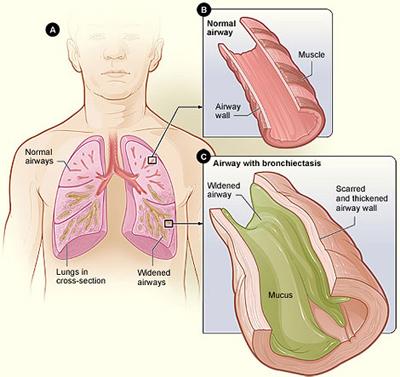On October 20, 2011, the U.S. Bronchiectasis Research Registry enrolled its 1,000th patient, a significant milestone in the fight against a rare lung condition that typically affects adults (mostly women) in the United States between 60 and 80 years of age.
The registry consists of people willing to participate in clinical studies to better understand, diagnose, prevent, and treat the disorder. One-thousand registry participants may not seem like very many, but only about 110,000 people in the United States have bronchiectasis, so this pool of participants actually represents a relatively substantial proportion of the overall patient population. Studying these patients will make significant contributions to the field.

Figure A shows a cross-section of the lungs with normal airways and widened airways. Figure B shows a cross-section of a normal airway. Figure C shows a cross-section of an airway with bronchiectasis.
A Debilitating Disease
Bronchiectasis is characterized by enlarged airways that are chronically infected with bacteria. Disease symptoms include wheezing, shortness of breath, coughing up thick mucus, and bleeding in the lungs. There is no cure for the disease, but treatments that clear the lungs of mucus and antibiotics that clear the airway of infections can help. In some cases, parts of the lung must be removed. With treatment, most people can live relatively normal lives, but early detection and diagnosis are critical.
Approximately one-third of all bronchiectasis cases are caused by cystic fibrosis, a genetic disorder that causes the body to overproduce mucus in the lungs and digestive tract. Bronchiectasis also can be caused by an inherited condition called primary ciliary dyskinesia, in which the hair-like structures (cilia) that line the inside of the nose, middle ear, and lungs are unable to clear the body of inhaled particles such as bacteria. Some cases of bronchiectasis have no known cause.
Registry Brings Patients Together
The Chronic Obstructive Pulmonary Disease Foundation established the U.S. Bronchiectasis Research Registry in 2008. The registry was developed to ensure that researchers would have ready access to a pool of people willing to participate in studies designed to enhance understanding of the types of bronchiectasis not caused by cystic fibrosis (non-CF bronchiectasis). Non-CF bronchiectasis can be difficult to diagnose and treat, hence the need to study this select group of patients.
Currently, 16 sites across the United States participate in the registry, including one at the National Institutes of Health (NIH) in Bethesda, Maryland, led by Kenneth Olivier, M.D., a researcher in the NIAID Laboratory of Clinical Infectious Diseases.
In addition to overseeing the NIH registry site, Dr. Olivier chairs a clinical study focused on bronchiectasis within a network of research centers, called the Genetic Disorders of Mucociliary Clearance Consortium, which is part of the Rare Diseases Clinical Research Network. In its initial phase, the consortium focused on patients with known or suspected genetic disorders of the respiratory cilia or primary ciliary dyskinesia, but it now has expanded to include studies on bronchiectasis caused by unknown factors.
The goals of the consortium are to identify genes associated with disease, improve diagnostic testing, and develop new treatments. The Bronchiectasis Research Registry may help identify patients willing and eligible to participate in studies conducted by the consortium as well as other clinical trials aimed at understanding or treating the disorder.
Seeking More Participants
Reaching the 1,000th patient in the Bronchiectasis Research Registry is a great accomplishment, but researchers hope that more people will join the effort to find a cure for this disease. Patients interested in participating should speak with their primary care physician; enrollment in the registry is by referral and must be completed through one of the 16 participating sites.
Learn more about the registry and see the other participating sites at the Bronchiectasis Research Registry website.
Read more about related ciliary disorders and find out how you can participate in a study by visiting the Genetic Disorders of Mucociliary Clearance Consortium website.
Visit the National Library of Medicine MedlinePlus website for more information about bronchiectasis, cystic fibrosis, and primary ciliary dyskinesia.

